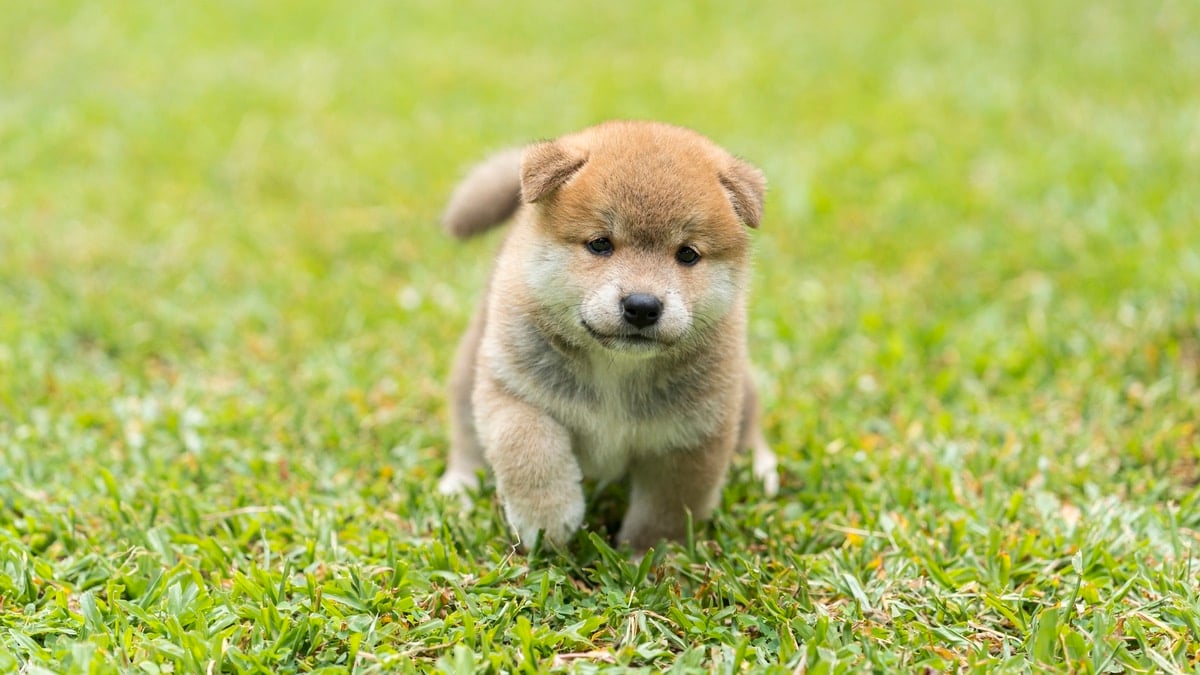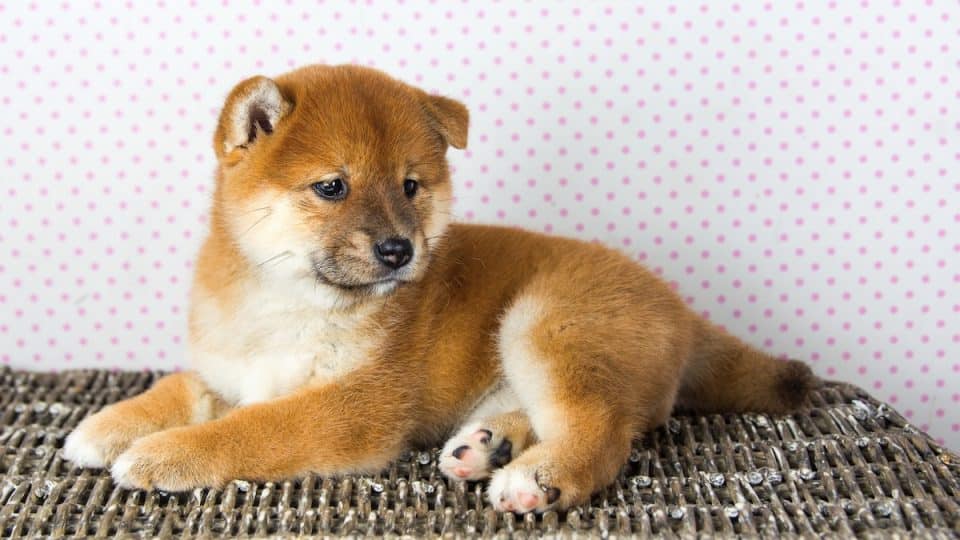- Not a substitute for professional veterinary help.
As puppies, Shiba Inus are all fluff and charm. While adult Shibas are known for being selective with their affection, especially around strangers and other pets, puppies tend to be more outgoing and open. With consistent socialization and positive reinforcement, a Shiba Inu puppy can grow into a confident, deeply loyal companion.
“Socializing a Shiba ‘early and often’ is the mantra for pet ownership,” says Jeri Burnside, public education committee liaison of the National Shiba Club of America (NSCA). “It’s important to give them ample opportunities to meet other dogs and people, always with lots of positive reinforcement.” Although they may never be big fans of snuggles with strangers, proper puppy training can make them calmer and more comfortable around new people and pups.
Upon reaching adulthood, Shibas develop fox-like features, with a stiffer, shorter double coat that sheds heavily twice a year. This popular breed can cost between $1,500 and $3,500 when purchased from a reputable breeder, with higher prices for Shiba Inu puppies from champion or show-quality bloodlines. Adopting a Shiba Inu puppy from a rescue organization is a more affordable option, with adoption fees typically ranging from $300 to $500.
Key Shiba Inu Puppy Facts
- Litter size: Shiba Inu litters can be on the smaller side, with an average of 3 to 5 puppies per litter.
- Puppy weight: These cute puppies weigh about 6 to 10 pounds by the time they’re ready to go home at 10 weeks.
- Puppy temperament: Shiba Inu puppies tend to be independent, confident drama queens, expressing dissatisfaction with a high-pitched “Shiba scream.” They require lots of positive reinforcement to be calm and on board with your ideas.
- Energy levels: With their high energy and high intelligence, Shiba Inu puppies can become destructive and bored without the right mental simulation.
- Maturity: Shibas typically settle into their personality and training by one and a half to two years of age.
- Unique traits: Known as the “cat-like dogs,” Shibas will develop a desire for personal space as they age.
- Bonding likelihood: Shiba Inus are most likely to pick one family member to bond with instead of having a whole human pack.
Where To Find Shiba Inu Puppies
From working with a responsible breeder to adopting from a rescue, there are several paths to finding your future best friend.
- Rescue groups: If going the rescue route, breed-specific organizations, such as the Shiba Inu Rescue Association or the Midwest Shiba Inu Rescue, specialize in purebred Shibas and Shiba mixes. Shiba puppies are rare at rescues and shelters—adult Shibas are more likely to be rehomed because their previous guardians were unprepared for their aloof and sometimes stubborn personality.
- Show breeders: Puppies from a show-quality bloodline typically adhere to breed standards, but you’ll still want to ensure the breeder can speak to the line’s personality, as an overfocus on appearance can lead to less stable temperaments. Wait times for puppies at these breeders can be pretty long, but the National Shiba Club of America is a great starting point for your search.
- Online marketplaces: You can also find a mix of Shiba breeders and rescues through online marketplaces, such as the American Kennel Club or Good Dog. If choosing a breeder through this route, familiarize yourself with potential puppy mill red flags, such as a breeder willing to part with a puppy too early or not sharing the parents’ health history.
Recommended health tests
“Shibas are generally a very healthy breed and often live well into their mid-teens,” says Burnside. “However, some hereditary conditions found in many breeds also occur in the Shiba.” These include hip, eye, and knee issues.
When working with a breeder or rescue, ask about your pup’s health history and ancestry to help identify potential genetic health risks. NSCA Public Education Committee Liason Piper Woodruff adds that potential adopters should familiarize themselves with the Orthopedic Foundation for Animals (OFA) Canine Health Information Center (CHIC) program. “Ideally, both parents of the puppy you’re interested in will have the recommended tests for the breed done and the results recorded on the CHIC database,” she says.
The NSCA and the OFA recommend several health screenings for Shiba Inu puppies:
- Patellar luxation evaluation: Shibas are prone to kneecap dislocation, also known as patellar luxation. This assessment helps determine the stability and strength of the kneecap.
- Hip evaluation: Hip dysplasia is a common risk factor among Shiba Inus, so it’s essential to assess the health of the dog’s hips and joints.
- Ophthalmologist evaluation: This exam monitors the risk for various eye disorders, such as glaucoma, which Shibas are prone to at quite an early age.
Shiba Inu Puppy Physical Characteristics
At the start of their life, Shiba puppies have folded ears, a straight tail, a teddy bear-like appearance, and a fluffy coat that can be red, black and tan, cream, or sesame. They also boast unique whitish markings around their face, chest, legs, and tail, known as “urajiro.”
A newborn Shiba weighs only 3 to 7 ounces and will grow rapidly in the first few weeks of life. With that growth comes high energy, which will likely peak during your Shiba puppy’s adolescent months. “As Shibas age, their energy levels may naturally decline a bit,” says Burnside, “although they are always a breed that’s up for a nice walk and daily exercise.”
| Age | Approximate Height | Approximate Weight | Tips |
| 8 weeks (2 months) | 6-7 inches | 4-6 pounds | Provide a safe, puppy-proof space for your Shiba and create a routine for sleeping, eating, and potty training. |
| 12 weeks (3 months) | 7-10 inches | 6-9 pounds | Your Shiba puppy is in his prime teething and exploration phase, so you’ll want to monitor closely. Early socialization will also help ensure a confident pup. |
| 16 weeks (4 months) | 10-12 inches | 9-14 pounds | Vaccinations should be complete at this point, so you can explore more of the world. Keep your pup secure on a leash and make sure your backyard is escape-proof, as Shibas are known to wander off. |
| 26 weeks (6 months) | 12-14 inches | 14-18 pounds | Your Shiba puppy will be entering the teen stage and needs plenty of mental and physical enrichment. |
| 34 weeks (8 months) to 1 year | 13-15 inches | 18-20 pounds | Continue socialization to combat Shiba aloofness. Talk to your vet about switching to adult food at one year. |
| 1.5 to 2 years | 15-17 inches | 20-23 pounds | Even though your Shiba pup will be physically and mentally mature at this stage, continue training to ensure a well-rounded adult. |
Raising a Well-Adjusted Shiba Inu Puppy
“People interested in adding a Shiba to their life should be aware that they are an independent hunting dog by nature,” says Woodruff. “The successful owner will use positive reinforcement training, and recognize that this is a breed where you say ‘sit’ and they will say ‘why?’ It behooves you to have a good answer!”
Breed-specific training needs
Because Shibas are known for their stubborn streak, choice-based learning often works well for Shibas. This type of training involves reinforcing a variety of preferred behaviors early in puppyhood, so your Shiba has a vast repertoire from which to choose. For instance, rewarding your Shiba pup for sitting, lying down on a mat, or going to their crate while you’re cooking dinner will give them plenty of alternatives to counter surfing or Shiba screaming for the tasty food in your hand.
If training becomes difficult, give your Shiba space to decompress and try again when you’re both feeling ready. Seeking the support of a professional trainer can also help you troubleshoot breed-specific issues and devise creative solutions.
A good dose of patience will also go a long way. Training a Shiba puppy is no easy feat. But with consistency and positive reinforcement, you can build a strong bond based on mutual respect.

IStock / Thirawatana Phaisalratana
Socialization
Socialization for Shiba puppies is especially critical since this breed can be stand-offish and reclusive. Work from a broad socialization checklist, including:
- Socialization around people and dogs
- Socialization to sounds to prevent later sound sensitivity
- Body handling socialization (especially nail trims)
“Owners should begin working on appropriate behavior for veterinary visits and grooming from puppyhood,” says Woodruff. “This is not the breed where you want the first bath to be when the dog is a year old. Foundational behaviors require effort.”
Crate and potty training
Shibas are fastidiously clean dogs, so potty training is often very straightforward. You’ll likely still want to explore crate training for your pup, however, as Shibas usually benefit from having their own space. Just ensure that crate training is fun and the crate is a refuge, not a place for separation due to punishment.
Lifestyle exercise and activities
Burnside says that even the most well-trained Shiba may never achieve reliability off-leash, due to their independent nature and high prey drive. Shibas are notorious escape artists, so a securely fenced area is vital for exercise and play. Shibas also thrive when provided with puzzles, games, and nosework, which keep their brains sharp.
While this breed was bred for traversing the mountains and will enjoy hiking, you’ll want to keep your Shiba securely on a leash and dedicate time to learning how to redirect their high prey drive since you’ll likely encounter wildlife on the trail.
Grooming Routine for Shiba Inu Puppies
Shibas have a dense double coat that sheds a lot. To combat this, many Shiba guardians take their dogs to a professional groomer, especially during seasonal blowouts. If you plan to do the same, get your Shiba puppy used to being touched as soon as possible.
Many Shibas also dislike having their paws touched. Desensitizing them early during puppyhood and practicing paw handling can make nail trims so much easier. Since Shibas are also prone to eye issues, it’s also a good idea to practice administering eye drops during your early training.
Health Considerations
Regular vet visits are essential for monitoring your Shiba puppy’s health and catching early signs of illness. Because Shibas can be runners, take time to escape-proof your home and yard. Additionally, ensure your pup’s microchip information is up-to-date, and invest in a pet insurance plan to cover any accidents.
It’s also a good idea to consult your vet about the best diet for your Shiba, especially if they’re a picky eater. Ensuring they get enough protein and essential nutrients is key to their growth and overall well-being.
Essential Shiba Inu Puppy Checklist
Welcoming a Shiba Inu puppy into the family is exciting! Before your canine companion arrives home, ensure you have everything you need.
- Walking gear: Choose a safe and secure harness and leash for your pup.
- Crate: Shibas love their space, so their crate should be a cozy, safe haven. Invest in a crate that is the proper size and allows your puppy to grow.
- Enrichment: Scent toys, such as snuffle mats, and mental enrichment, like puzzle toys, can keep your Shiba puppy’s brilliant brain busy.
- Training: Shiba puppies will benefit from group classes, as they provide extra opportunities for socializing with different dogs and people.




